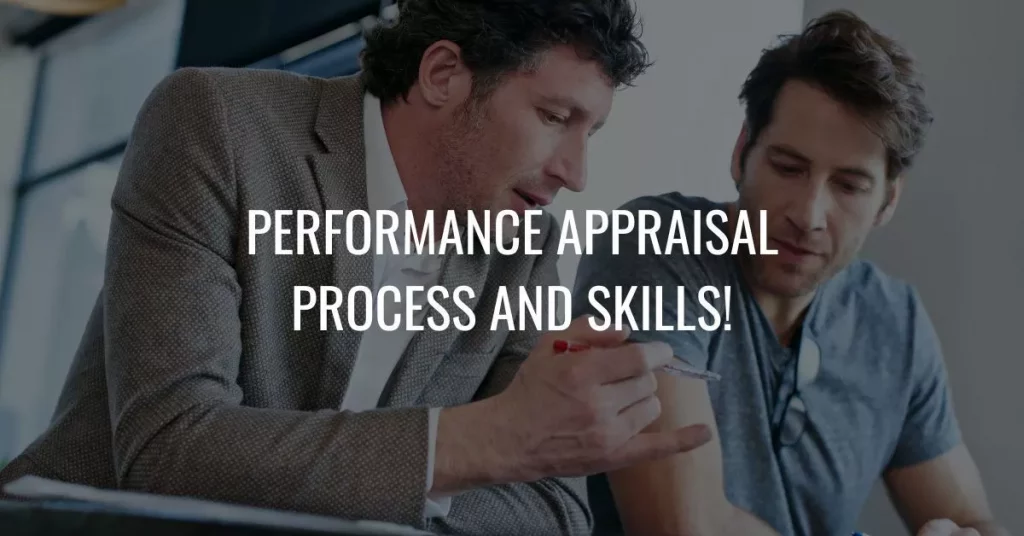Performance Appraisal Process And Skills!
Generally, companies hold a formal review of all employees at least once a year. This review is often called a performance appraisal.
The emphasis here is formal reviews since managers should discuss performance with employees as frequently as possible throughout the year. When the year is over for a particular employee, the manager should hold a planned, guided, personal interview with the employee.
Before the performance appraisal interview the manager should set a standard or system to compare the actual performance with the system:

A good review system for performance appraisal:
The following represents aspects of our appraisal system that are beneficial to both employees and the company.
- The appraisal for improving the performance:
The evaluation isn’t to punish the employees; it aims to improve employees’ performance to the benefit of customers, stockholders, and employees
Some bad managers make the performance appraisal to punish the employees, but in this way, the review doesn’t have any benefit to customers, stockholders, or employees.
And the employees won’t have any loyalty to the organization, they work only for money and their job so they don’t give the organization any extra work, effort, or mind.
- The system is fair and provides an equal opportunity for all to receive ratings that their performance justifies.
The system must be fair for the organization’s and manager’s credibility, and if the system isn’t fair this will generates hatred between the employees and managers.
- The evaluation should be for SMART goals.
- All employees should know what criteria are used to rate, and the managers should teach the employees those criteria on day one in their job and at every evaluation time.
- The managers should minimize subjectivity in performance appraisal because by pure subjectivity the evaluation won’t be fair.
- Ratings are based on actual observation, the manager should observe the employees continually by watching what they do and what their work’s outputs are.
- Because anyone makes common human errors, so the common human rating errors should be eliminated or minimized in the evaluation.
Benefits resulting from the review system.
The following list shows the benefits to both employees and managers when the review is done correctly:
- Enables you to make more intelligent decisions about your employees.
- Tells you how well the individual is doing.
- Tells you what skills, interests, and potential the employees have.
- It helps in identifying promotable employees.
- Helps in identifying people who may be on the wrong assignment.
- Helps to identify training needs
- Provides you with an opportunity for personal discussion with your people to aid them in improving performance.
- Points out gradual changes that may have occurred in a person’s job performance over a period of time.
The review process
The following are basic steps of a good review process:
Set date, time, and place:
Make the review time divided into two parts, it is recommended that 1/3 of the estimated time for evaluation and 2/3 of the estimated time for suggestions for improvements.
- Ask the employee to be prepared to discuss the final review and give him enough time to be ready.
- Collect all needed data against the objectives from available resources such as, statistical reports, oral reports, written reports, and personal observations, and summarize them in a written memo.
- List the actual performance, any deviation from the desired performance of the employee, and the deviations’ reasons.
- Note any improvements, accomplishments, and direction of effort, trends, and growth because this way encourages the employees; and sets suggestions to enhance them.
- Consider any special circumstances or conditions, difficult assignments, and special priorities.
- Include the entire year and exclude other years
- Set initial evaluation degrees and the final evaluation will be with the employee during the review interview.
Start to rate the employee:
Now that you have prepared yourself and the employee, you’re ready for the face-to-face interview.
- As you speak with the employee, you should keep in mind the following:
- To openly and freely discuss his performance.
- Therefore, try to hold the meeting in a relaxed informal setting; try to put the employee at ease.
- Be sure to clarify the purpose of your discussion to improve the performance.
- Review previous evaluations and ratings to know the improvement rate of the employees.
- Discuss with the employee reasons for deviations between actual and desired performance also you should discuss the employee’s skills, knowledge capabilities, strengths, and weaknesses.
- Introduce improvement suggestions:
The most important thing is to be prepared to introduce improvement suggestions because the main purpose of the review is to improve the employee’s performance.
Setting new objectives:
Again, follow the suggestions made earlier regarding the atmosphere or climate for holding employee meetings.
Having completed the performance, you and the employee should now set new objectives for the next year.
Keep in mind the objectives must be realistic in terms of the employee’s strengths and should be SMART objectives and important for the company or employee.
- The interview should be done with mutual agreement, therefore ask the employee to state the new objectives he/she feels needs to be accomplished.
- Then communicate your expectations- what you feel the employee needs to accomplish in the coming year.
- The most important thing, when you and the employee set objectives for the next year you should explain to him/her why?
- Why goals are important to the company?
- Why Goals are important to the department?
- And the most important why objectives are important to the employee?
- Will the objectives help him/her learn more?
- Will the objectives help in obtaining a better position?
- Will the objectives help in the improvement of particular job skills?
- Will the objectives help in increasing the income?
It’s important to emphasize that objectives should be aligned with the corporation’s goals, the strategic plan, and the business plan as well as those objectives necessary to support other departments.
Close the interview:
Every review must have closed. The following two steps will ensure that you have a full understanding of what to be done next.
- As you close this interview, keep in mind your desired mutual agreement on the objectives, that you see the achieving of the goals as a collaborative effort, and that you will hold progress review steps.
- Conclude the interview by having the employee summarize the agreed- on-objectives and steps and close by expressing confidence in the employee.
- It’s important that both manager and employee agree on the standard for measuring results.
- Communicate the rating with your supervisor and others as required and forward a copy to the personal file.

Patrick is a lifelong learner and personal development blogger whose work focuses on mindset shifts, emotional growth, and the hard-won lessons from real-life challenges.
Qualities: Relatable, honest, introspective, growth-oriented.
